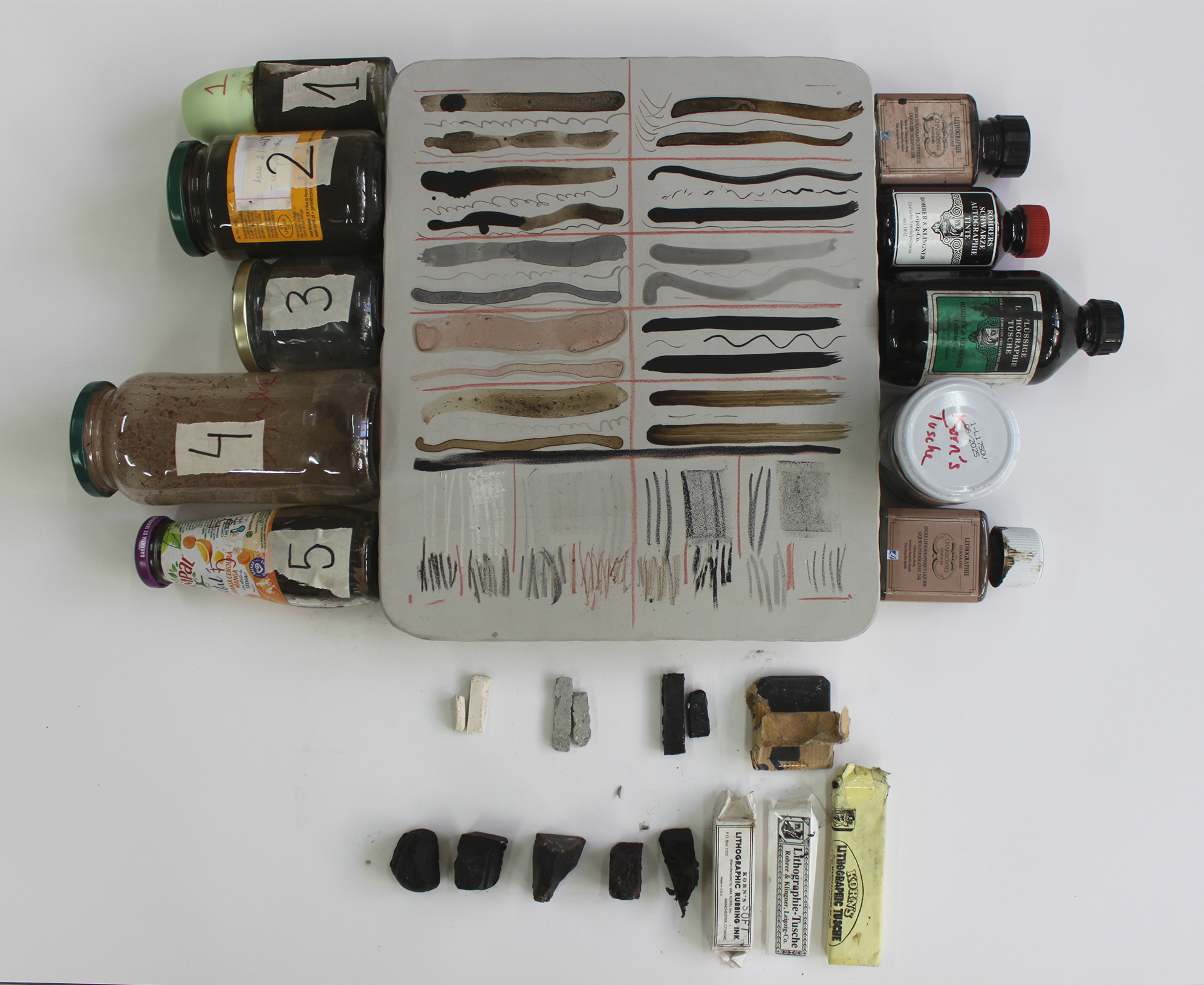Abstract
With the advancement of the ink manufacturing industry and methods in the 19th century, it has been argued that artists lost intimacy with the raw materials used in almost all techniques. The composition of ingredients in even the most common drawing and printing inks, tusches, or crayons became a mystery. If, on one hand, the advancement of chemistry and industry allowed the improvement of paints and led artists to understand how to combine them, on the other hand, putting high-quality ready-to-use materials on the market pinpointed the beginning of the broken connection between artists, raw materials, and the process of their fabrication. The model of work in this research is posited in a more complex and desirable situation, such as working in situ as opposed to a well-provided printmaking workshop. To achieve a better understanding of local culture, this research aims to deepen the knowledge of the processes embodied in the use of print media and the construction of artists’ tools. The local black slate, used as a matrix for lithographic printing, its colourful variation for coating papers, gum printing, inks, and crayons, extend the innovative experimental approaches and offer a variety of strategies to understand and read local collective memories and the history of communities. Reconstructing 19th-century materials used in commercial printing or looking at vernacular buildings makes us consider the use of hereditary methods and knowledge and the need to include traditional skills and craftsmanship. It prompts us to learn from a constructive culture that has been informed by the collective memory of knowledge and skills, both popular and erudite, and to acknowledge these repositories of knowledge as evidence of the dynamic connection between the past and future of humankind’s adaptation to the environment, where printmaking in situ may have a role in negotiating culture and history.
References
Béguin, A. (1977) Dictionnaire technique de l’estampe, Brussels.
Bełkot, M., Machado, G. (2021) Making surfaces and exploring print-based practices: The lost history of prepared surface papers. IMPACT 11 – International Printmaking Conference, Hong Kong, China.
https://www.impact11.hk/application/en/submission/submission-l9vg264p/
Cruz, A. J. (2009) Os materiais usados em pintura em Portugal no início do século XVIII, segundo Rafael Bluteau. Accessed online on 30.07.2021:
Daston, L., Galison, P. (2007) Objectivity, Zone Books, New York.
Howe, K. S., Ed. (1998) Lithography, Photography, Intersections and the Traditions of Printmaking. The Tamarind Papers. University of New Mexico Press, Albuquerque.
Lehner, S. (1902) Ink manufacture including writing, copying, lithographic, marking, stamping, and laundry inks. Scott, Greenwood, and Co., London. (p. 4)
Lemercier, A. (1896). La Lithographie Française de 1796 à1896. Ch. Lorilleux et Clé, Paris.
Loureiro, O. (2001) O Caixeiro e a Instrução Comercial no Porto Oitocentista. Op. Cit. p. 78; Cit. De Pereira, José Manuel Tese de mestrado, 2º capítulo.
Machado, G., Bełkot, M. and Brás, S. (2022) Gillotage. Exploring a mid-nineteenth-century relief printing technique. https://www.impactprintmaking.com/article/issue-5-gillotage/
Machado, G. & Bełkot, M. (2019) Drawing for Reproduction: Towards recreating surface-prepared papers for making prints and exploring creative practice. CONFIA, Viana do Castelo, Portugal.
Mayer R. (1991) The Artist’s Handbook of Materials and Techniques, The Painter’s Craft, and A Dictionary of Art Terms and Techniques. Fifth Edition, Revised and Updated, Viking Books, USA
Netsky, R (1982) Albert Winslow Barker: Graphite Crayons and Sea Salt, p.18. Tamarind Institute. Volume 6, Number 1. The Tamarind Papers: Technical, Critical and Historical Studies on the Art of the Lithograph 6, p.18 https://digitalrepository.unm.edu/tamarind_papers/vol6/iss1/1
No author. (1925) Mil Segredos de Oficinas. Lisbon, Portugal
Rhodes, H. J. (1914) The Art of Lithography. Scott Greenwood and Son, London.
Senefelder, A. (1819). A Complete Course of Lithography, R. Ackermann, London.
Villon, A. M. (1932) Dessinateur et imprimeur lithographe. Paris: Societé française editions littéraires et techniques, p.47
Brégeaut, R. L. (1850) Nouveau manuel complet de l’imprimeur lithographe (Nouvelle édition très augmentée) Paris.
Brégeaut, L. R. (1827) Manuel complet théorique et pratique, Roret, de l’imprimerie de Crapelete, Paris.
Champour, M. M., Malepeyre, F. (1875). Nouveau manuel complet de la fabrication des encres de toute sorte...; suivi de la fabrication du cirage (Nouvelle édition considérablement augmentée) Roret, Paris
Cumming, D. (1948) Handbook of Lithography. A&C Black, LTD. London (p. 20)
Costa, J., Valladares, M. (1888) Bibliotheca do Povo e da Escola. 20ª série, nº155.

This work is licensed under a Creative Commons Attribution 4.0 International License.
Copyright (c) 2023 Marta Belkot , António da Silva, Rafaela Lima, Graciela Machado
